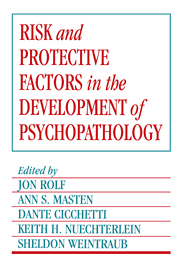Book contents
- Frontmatter
- Contents
- List of contributors
- Preface
- Part I Introduction: Historical and theoretical roots of developmental psychopathology
- Part II Contributions of the high-risk child paradigm: continuities and changes in adaptation during development
- Part III Competence under adversity: individual and family differences in resilience
- Part IV The challenge of adolescence for developmental psychopathology
- 14 The development of psychopathology in adolescence
- 15 Depressive symptoms in late adolescence: a longitudinal perspective on personality antecedents
- 16 Vulnerability and resilience in the age of eating disorders: risk and protective factors for bulimia nervosa
- 17 Protected or vulnerable: the challenges of AIDS to developmental psychopathology
- Part V Factors in the development of schizophrenia and other severe psychopathology in late adolescence and adulthood
- A closing note: Reflections on the future
- Author index
- Subject index
14 - The development of psychopathology in adolescence
Published online by Cambridge University Press: 06 August 2010
- Frontmatter
- Contents
- List of contributors
- Preface
- Part I Introduction: Historical and theoretical roots of developmental psychopathology
- Part II Contributions of the high-risk child paradigm: continuities and changes in adaptation during development
- Part III Competence under adversity: individual and family differences in resilience
- Part IV The challenge of adolescence for developmental psychopathology
- 14 The development of psychopathology in adolescence
- 15 Depressive symptoms in late adolescence: a longitudinal perspective on personality antecedents
- 16 Vulnerability and resilience in the age of eating disorders: risk and protective factors for bulimia nervosa
- 17 Protected or vulnerable: the challenges of AIDS to developmental psychopathology
- Part V Factors in the development of schizophrenia and other severe psychopathology in late adolescence and adulthood
- A closing note: Reflections on the future
- Author index
- Subject index
Summary
Our society holds contradictory beliefs about adolescent psychopathology. Some of these beliefs are myths that have impeded adequate conceptualization of psychopathology in adolescence and have encouraged stereotypes about “normal” adolescent development as well. In this chapter we briefly discuss these myths relative to the empirical evidence. We then provide an overview for a developmental perspective on psychopathology in adolescence, along with the related implications and issues.
Myths about adolescent psychopathology
Myth 1: Psychopathology is a normal state in adolescence
The belief that psychopathology in adolescence is normative stems primarily from psychoanalytic theory (Bios, 1962; Freud, 1958). Psychoanalytic theory proposed that disturbances in adolescence, leading to neurotic or psychotic states, were created as a result of the effects of pubertal changes on impulses (Kestenberg, 1968). According to Bios (1962), these impulses, particularly sexual impulses, threatened the parent-child relationship and required greater separation and differentiation between child and parent. From that perspective, adolescent upheavals and disturbances, though often difficult to distinguish from “true” pathology, were considered normal and healthy expressions of adolescent development (Freud, 1958). Rebellion and conflict with parents were similarly viewed as normative. Resolution of this developmental crisis was thought to be necessary for normal development to proceed. Failure to resolve this crisis, manifested in adolescent turmoil, would lead to repression of the conflict, resulting in a reemergence of the conflict later in life, typically in a “middle-life crisis” (Vaillant, 1977).
In contrast, epidemiological research, both in the United States and in other countries, suggests that no more than 20% of youngsters in the adolescent age span manifest diagnosable disorders during these years (Graham, 1979).
- Type
- Chapter
- Information
- Publisher: Cambridge University PressPrint publication year: 1990
- 16
- Cited by



